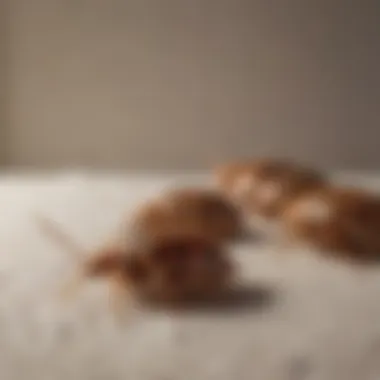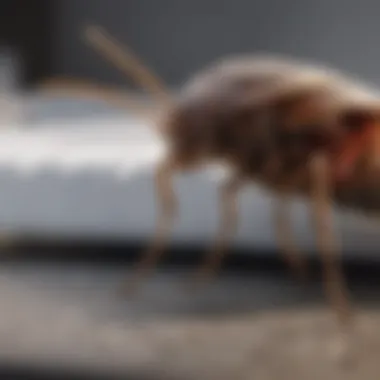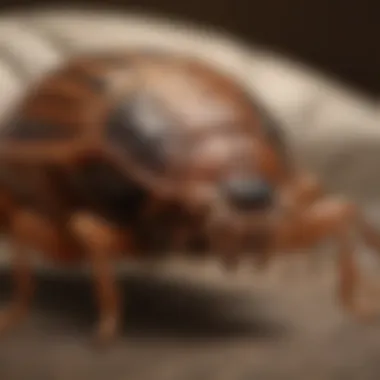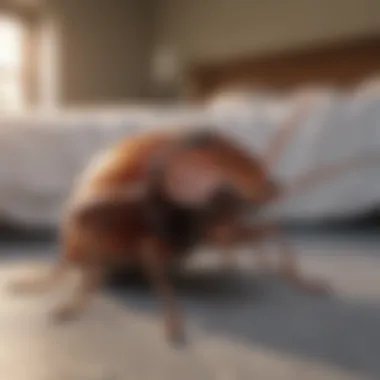The Efficacy of Heat in Bed Bug Extermination


Intro
Bed bugs present a persistent challenge for homeowners and pest control professionals alike. Understanding how to effectively manage and eliminate these pests is critical. With their resilience and ability to hide in small crevices, traditional pest control methods often fall short. In this context, heat treatment emerges as a powerful alternative.
Pest Identification
Accurate identification of bed bugs is a fundamental step in addressing an infestation. Unlike other pests, bed bugs are small, nocturnal insects that feed on human blood. They typically measure about 5 to 7 millimeters in length, appearing reddish-brown, and have a flat, oval shape.
Detailed Descriptions of Common Pests
Bed bugs belong to the Cimex lectularius species. They are known for their exceptional resilience and reproductive capabilities. A single female bed bug can lay hundreds of eggs within her lifetime. The young nymphs are nearly translucent and can be difficult to spot, especially during the earlier stages of their life cycle.
Signs and Symptoms of Infestations
Recognizing a bed bug infestation is essential for timely intervention. Common signs of bed bug presence include:
- Bite Marks: Itchy, red welts can appear on the skin, often arranged in clusters.
- Droppings: Dark, rust-colored spots on bedding or furniture may indicate fecal matter.
- Egg Casings: Tiny, discarded shells can often be found in hiding spots.
- Musty Odor: A distinct scent may emanate from heavily infested areas.
Prevention Strategies
Effective prevention plays a key role in controlling bed bug populations before they become a significant problem.
Home Maintenance Tips for Pest Prevention
Homeowners can adopt several practices to reduce the likelihood of an infestation:
- Regular Inspections: Routinely check beds, upholstery, and common hiding spots.
- Declutter: Minimize clutter to reduce potential hiding areas for bed bugs.
- Seal Cracks: Use caulking to seal gaps and crevices in walls and furniture.
- Wash Bedding: Regularly wash and heat-dry bed linens and clothing.
Natural Deterrents and Barriers
Incorporating natural deterrents may provide additional layers of protection. These can include:
- Diatomaceous Earth: This natural powder can be sprinkled in hiding spots. It is non-toxic and lethal to insects.
- Essential Oils: Some oils, such as lavender and tea tree, have been noted to repel bed bugs, though they may not eradicate them.
Treatment Options
When an infestation is confirmed, various treatment options come into play.
Overview of Chemical vs. Natural Treatments
Homeowners often weigh the benefits of chemical versus natural treatments. Chemical solutions may provide quick action but could pose health risks if not applied carefully. In contrast, natural methods are generally safer, yet might require more persistent effort for successful eradication.
Step-by-Step Guides for DIY Treatments
- Preparation: Remove bedding and wash it in hot water. Vacuum the infested area thoroughly.
- Heat Application: Use portable heaters or professional service, ensuring the area reaches at least 118°F (48°C) to kill bed bugs.
- Follow-Up: Continue to monitor the area after treatment, looking for signs of returning pests.
Excessive reliance on chemical treatments can lead to resistance in pest populations. It’s crucial to combine methods for optimal effectiveness.
Effective bed bug management requires understanding their behavior, life cycle, and the methods available for their extermination. With a comprehensive strategy centered on heat treatment, homeowners can significantly enhance their chances of eliminating these persistent pests.
Understanding Bed Bugs
Understanding bed bugs is fundamental to effectively address their extermination. Bed bugs, scientifically known as Cimex lectularius, are small, wingless insects that feed on the blood of humans and animals. Their ability to rapidly reproduce and adapt makes them particularly challenging to eliminate. By grasping their biology and behavior, homeowners can make informed decisions regarding pest control methods, including heat treatment.
Biology and Behavior
Bed bugs are nocturnal creatures, primarily active at night. They typically hide in crevices and seams of furniture, behind wallpaper, or in the folds of bedding during the day, making them difficult to spot. A female bed bug can lay up to five eggs per day, resulting in a population explosion if not addressed quickly. Their lifecycle consists of several stages: egg, nymph, and adult, with nymphs appearing similar to adults but smaller. Each stage requires blood to mature, emphasizing the importance of timely intervention in infestations.


Bed bugs are resilient pests, with a remarkable ability to survive without blood for several months. They thrive in warm environments, often infesting homes, hotels, and other places where people sleep. Their presence can lead to sleepless nights and psychological distress, making it crucial to recognize and address signs of infestation promptly.
Signs of Infestation
Identifying bed bugs early can be vital for effective extermination. Here are some common signs of infestation:
- Bites on Skin: Itchy welts on exposed skin often appear in a linear pattern, indicating bugs feeding while a person is asleep.
- Blood Stains: Small, red spots on bedding or mattresses may indicate crushed bed bugs.
- Fecal Matter: Tiny, dark brown or black spots on sheets or nearby surfaces may also signify an infestation.
- Eggs and Shells: Finding small, white, oval eggs or transparent exoskeletons in the hiding spots can confirm the presence of bed bugs.
Early detection and understanding the behavioral patterns of bed bugs will greatly improve the chances of successful eradication.
In summary, understanding bed bugs is essential for effective pest management strategies. Recognizing their biology and signs of infestation allows homeowners to act swiftly and ensure the success of extermination methods, including the use of heat treatment.
The Science of Heat Treatment
Understanding the science behind heat treatment is essential for effective bed bug extermination. This method capitalizes on bed bugs' vulnerability to extreme temperatures. Heat, as opposed to chemical methods, offers a more holistic approach that directly targets all life stages of the pests, from eggs to adults. When high temperatures are properly applied, they can effectively eliminate infestations, making this method a valuable tool in pest control.
Moreover, heat treatment is increasingly preferred for its environmentally friendly properties. It minimizes the use of chemical pesticides that can pose health risks to humans and pets. Recognizing the temperature thresholds and understanding how heat operates will significantly enhance the success rates of extermination efforts.
Temperature Thresholds for Bed Bugs
Bed bugs can endure a range of temperatures, but they are not immune to heat. Research indicates that bed bugs and their eggs begin to succumb at temperatures above 113°F (45°C). When exposed to this heat for around 90 minutes, significant mortality rates can be achieved. However, to ensure complete extermination, temperatures must reach about 118°F (48°C) as this will provide more reliable results.
Table summarizing tolerable temperatures:
| Temperature (°F) | Expected Outcome | | 113°F (45°C) | Begins mortality (90 min) | | 118°F (48°C) | Higher mortality rate (30 min) | | 125°F (52°C) | Near complete extermination (5 min) |
Effective treatments often maintain 130°F (54°C) for better assurance in eliminating bed bugs. Understanding these thresholds is vital for anyone undertaking heat treatments, whether professionally or as a homeowner. It establishes the framework needed for successful extermination while guiding safe practices.
Mechanism of Heat Elimination
Heat eliminates bed bugs primarily through dehydration and protein denaturation. Upon exposure to sufficient temperatures, bed bugs start losing moisture, leading to desiccation—a fatal result for these pests. As temperatures rise beyond critical levels, proteins within the bugs' bodies begin to break down, leading to cellular damage and death.
The application of heat can be done using specialized machines that circulate hot air. This ensures that all infested areas, even those hard to reach, receive uniform heat distribution.
Key aspects of effective heat treatment include:
- Uniform Coverage: Utilize fans and specialized heaters to ensure consistent temperatures throughout the treated space.
- Monitoring: Employ thermal sensors to track temperature in various locations and verify that key thresholds are achieved and maintained.
- Duration: Maintain heat for an adequate time to ensure even the most hidden bed bugs face unfavorable conditions.
Proper heat treatment not only eliminates visible pests but also precludes future infestations by targeting the whole population even within sheltered areas.
In summary, understanding the science of heat treatment provides critical insights that should guide pest control efforts. Knowledge of temperature thresholds and the mechanisms of heat elimination enhances both effectiveness and safety in treating bed bug infestations.
Methods of Heat Application
Heat treatment is a vital method for eliminating bed bugs, as it effectively disrupts their life cycle and eradicates them at all stages. Understanding how to properly apply heat is essential for homeowners and pest control professionals alike. The method chosen can significantly affect the success rate of extermination and the safety of the household. Moreover, it is important to consider factors such as the severity of the infestation, the areas that need treatment, and the available tools or resources.
Professional Heat Treatment
Professional heat treatment is conducted by licensed exterminators who utilize specialized equipment designed for this purpose. This method involves heating rooms to a temperature between 120°F to 140°F (49°C to 60°C) and maintaining that temperature for a specific duration, usually around 90 minutes to two hours. Here are some key points that reflect the benefits of this method:
- Expertise: Technicians have the knowledge and experience to handle various situations effectively, ensuring that all areas are treated adequately.
- Equipment: Professionals use advanced technology like electric heaters and thermal imaging cameras to ensure optimal coverage and track temperatures.
- Safety: Authorized pest control services follow safety protocols, minimizing risks of fire hazards and damage to belongings.
The major advantage of hiring professionals is that they guarantee a thorough job. They inspect the site before treatment and often recommend follow-up visits to ensure bed bugs do not return. However, these services can be costly, and some homeowners may not have the means to afford them.
DIY Heat Applications
While hiring professionals is the most effective way to approach a heat treatment, do-it-yourself methods can be a viable option for some. Homeowners may opt for DIY solutions to manage mild infestations or supplement the efforts of professional services. Here are common DIY methods:
- Portable Heaters: Utilizing portable heaters is one way to apply heat to localized areas. Consumers need to ensure that the temperatures are tracked closely.
- Steam Cleaning: A steam cleaner can be effective for treating fabrics such as bedding and upholstery. The steam must be applied directly, ensuring that the material reaches a temperature sufficient to kill bed bugs.
- Clothing and Items in the Dryer: Placing infested items in a dryer set to high heat for at least 30 minutes can kill bed bugs effectively.


However, DIY methods have limitations. Ensuring even heat distribution across all surfaces can be challenging, and some methods may not reach the necessary temperatures. Misapplications can lead to incomplete extermination or, in worse case scenarios, can cause fires.
Effective heat application is critical in combating bed bug infestations. Miscalculating or ineffective methods can lead to wasted efforts and increased frustration.
Effectiveness of Heat Treatment
The topic of heat treatment effectiveness is crucial in the battle against bed bugs. These pests pose a significant threat to both comfort and health, often leading to emotional distress and financial burden. Heat treatment emerged as a preferred solution due to its efficacy in targeting the various life stages of bed bugs. It is essential to understand its capabilities and limitations.
Heat treatment targets bed bugs by raising temperatures to lethal levels for these insects, typically above 120°F (49°C). This process disrupts their ability to seek shelter, reproduce, and survive.
Success Rates in Extermination
Studies indicate that heat treatment can achieve success rates exceeding 90%. The effectiveness hinges on consistent temperature maintenance throughout the infested area. For example, pest control companies often utilize specialized equipment to ensure that heat penetrates all surfaces. This includes furniture and hidden crevices where bed bugs can nest.
The combination of heat and strategic application methods significantly reduces the likelihood of bed bug survival. Bed bugs are highly resilient, but exposing them to heat for longer durations increases elimination rates.
Limitations and Challenges
Despite its proven efficacy, heat treatment does have notable limitations. One significant challenge is the potential for damage to personal belongings. Items made of materials that are susceptible to high temperatures may get affected. Consequently, homeowners must remove or protect such items diligently before treatment.
Another limitation is the potential for uneven heating. If certain areas of a home do not reach the required temperatures, bed bugs may survive and lead to reinfestation. Ensuring thorough coverage can be difficult in complex environments like cluttered bedrooms or multi-story homes. Additionally, there may be accessibility issues in certain locations, further complicating the effectiveness of the treatment.
"Successful heat treatments necessitate not just temperature control, but also careful strategic planning to maximize exposure for all targeted areas."
In summary, while heat treatment shows great promise in combative efforts against bed bugs, understanding its limitations aids homeowners in making informed decisions. Combining heat treatment with other methods may yield even more effective results. Proper planning, protective measures for belongings, and professional assistance can enhance the overall success of this pest control strategy.
Safety Considerations
When employing heat for bed bug extermination, safety considerations must be at the forefront of any method used. The potential hazards involved with heat treatment are significant, making it crucial to understand how to effectively mitigate associated risks. By adhering to safety guidelines and best practices, homeowners and pest control professionals can ensure not only an effective extermination process but also a safe environment for everyone involved.
Benefits of addressing safety considerations include preventing accidents, protecting valuable belongings, and ensuring that the heat treatment method does not unintentionally create more problems than it solves.
Preventing Fire Hazards
Any use of high temperatures in enclosed spaces demands attention to fire safety. It is essential to identify materials in the area that may ignite when exposed to intense heat. Common household items such as paper, plastic, and foam are particularly vulnerable. To prevent fire hazards, one should:
- Remove combustible materials from the treatment area. This includes everything from paper products to furniture upholstery that may catch fire.
- Ensure proper ventilation during the heating process. A poorly ventilated area can not only increase fire risks but also lead to overheating of certain objects.
- Utilize fire-resistant materials in areas where heat treatment occurs, especially if using portable heaters or chambers.
Following these steps creates a safer environment while thoroughly targeting bed bugs.
Protecting Personal Belongings
Implementing heat treatment can pose risks to personal belongings. Protecting valuable items is not only about preserving possessions but also about maintaining a sense of order and peace within the home during an invasive pest control process. Here are some important strategies:
- Remove and store valuables in a safe location. This includes electronics, important documents, and sentimental items. Utilizing airtight containers can also protect items from residual heat and other possible exposure.
- Cover furniture and surfaces with durable, heat-resistant materials if removal is not possible. This helps shield them from potential heat damage.
- Document valuable items before treatment as a safeguard. Taking inventory allows for easier recovery and assessment of any damages or losses post-treatment.
Adopting these precautionary measures minimizes the risk of accidental damage to personal belongings, ensuring that the focus remains on successful bed bug extermination while preserving the integrity of the home.
"Addressing safety in bed bug heat treatment safeguards both people and property, creating a more controlled eradication process."
By consciously preventing fire hazards and protecting personal belongings, individuals can ensure a smoother and safer eradication experience.
Common Misconceptions About Heat Treatment
Understanding common misconceptions about heat treatment is essential in effectively addressing the challenges of bed bug extermination. Many homeowners and even some pest control professionals possess misunderstandings that can impede the success of their pest management efforts. These myths can lead to inappropriate strategies that may not only fail but also exacerbate bed bug infestations.
One major benefit of debunking these misconceptions is the empowerment it gives homeowners and renters. When they have clear, factual information, they can make informed decisions regarding pest control methods that will genuinely work. Accurate understanding of heat treatment can ultimately save time, money, and effort in dealing with bed bugs.


Additionally, clarifying these myths helps to promote safer treatment practices, reducing the risk of danger associated with misguided approaches. This approach to knowledge can lead to increased awareness and more effective collaboration between homeowners and pest control experts.
Myths vs. Facts
Several myths persist about heat treatment for bed bugs. It is critical to distinguish facts from fiction to prevent misinformation from influencing pest control decisions. Here are some of the most common misconceptions:
- Myth: Heat treatment is only effective against adult bed bugs.
Fact: Heat treatment can kill all life stages of bed bugs, including eggs, nymphs, and adults, provided that the temperature is maintained at the appropriate levels for the right duration. - Myth: Any heating source can eradicate bed bugs.
Fact: It’s not just about temperature; the method of heating is also vital. Effective heat treatment requires targeted and even heating throughout the infested area. Household heaters may not reach the necessary temperatures or distribute heat uniformly, which can leave some bugs alive. - Myth: Once heat treatment is done, re-infestion is impossible.
Fact: While heat treatment is effective, it is not a guaranteed solution. Bugs may re-enter a property from nearby infested areas. Ongoing vigilance and preventative measures are essential to maintain a bed bug-free environment. - Myth: Heat treatment is more costly than chemical methods.
Fact: Although the initial investment for professional heat treatment can be higher, it often leads to quicker results and may require fewer repeat treatments compared to chemical methods, ultimately making it a cost-effective choice.
"Understanding the facts about heat treatment can drastically improve the approach to managing bed bugs, resulting in more effective extermination strategies."
By addressing these myths, homeowners can gain confidence in their pest control measures and improve their chances of successfully eliminating bed bugs.
Comparative Analysis of Pest Control Methods
When addressing the issue of bed bug extermination, it is crucial to understand the various methods available. A comparative analysis allows homeowners to make informed decisions about which pest control strategy to employ. This section focuses on two predominant approaches: heat treatment and chemical treatments. Both methods have their unique attributes, benefits, and limitations that warrant consideration.
Heat vs. Chemical Treatments
Heat treatment stands out as a highly effective means of eliminating bed bugs. It operates on the principle that exposing these pests to elevated temperatures, typically above 120°F, is lethal. This method not only targets bed bugs but also their eggs, ensuring comprehensive eradication. Moreover, heat treatment generally requires only a single application, making it efficient for those with time constraints.
In contrast, chemical treatments involve the use of pesticides that may impact a broader range of insects. However, bed bugs have shown increasing resistance to many commonly used chemicals. This resistance often necessitates multiple treatments, extending the duration of the extermination process. Additionally, chemical residues may pose health risks to humans and pets while also requiring considerable precautions during application.
The decision between heat and chemical methods also hinges on the potential for future infestations. While heat treatment substantially reduces the initial population, it does not provide a long-term barrier against new introductions. Chemical treatments, if successful, can offer ongoing protection. However, their effectiveness can diminish over time due to resistance.
"Understanding the strengths and weaknesses of each pest control option is essential for formulating an effective extermination strategy."
Integrating Methods for Enhanced Effectiveness
Utilizing a combination of heat treatment and chemical applications may yield optimal results in bed bug extermination. By integrating both methods, homeowners can achieve rapid elimination while also creating a protective barrier against possible re-infestations. For instance, following a thorough heat treatment, applying an insecticide can help target any surviving pests or newly introduced insects.
Moreover, this integrative approach allows residents to address the complexities of bed bug behavior. These pests often hide in hard-to-reach areas. Using heat can flush them out, while targeted insecticides can tackle those that escape. Additionally, the dual strategy can reduce the likelihood of developing pesticide resistance, as the pests are exposed to various methods of extermination.
Post-Treatment Steps
Post-treatment steps play a crucial role in ensuring the long-term effectiveness of heat treatment for bed bug extermination. After successfully eliminating these pests, it is vital to take proactive measures. This will help prevent future infestations and ensure that your living environment remains free of bed bugs. Failure to properly address post-treatment considerations can lead to a recurrence of the problem, which can be both frustrating and costly.
Preventing Re-infestation
Preventing re-infestation should be a top priority for homeowners. One key aspect is thorough cleaning of the affected areas. Washing all bedding, curtains, and clothing in hot water can eliminate any stray bugs or eggs. It's also essential to dry these items on high heat for at least 30 minutes. This method effectively eradicates not only adult bed bugs but also any eggs that may have escaped the heat treatment.
In addition to washing items, one needs to vacuum the entire premises passionately. Pay special attention to seams, edges, and crevices where bed bugs tend to hide. It is wise to dispose of the vacuum contents in an outside trash bin immediately to prevent any chance of reinfestation.
Another effective strategy is to use encasements on mattresses and box springs. These encasements are specifically designed to trap bed bugs inside, preventing them from escaping or feeding. It is important to ensure that these encasements remain sealed for at least a year, as adult bed bugs can survive for extended periods without feeding.
Finally, being vigilant about any new items brought into the home is crucial. Inspecting second-hand furniture or linens for signs of bed bugs can help avoid inadvertently introducing them back into your living space.
Maintaining a Bed Bug-Free Environment
Maintaining a bed bug-free environment requires ongoing vigilance and proactive measures. Regular cleaning is essential. Routine vacuuming of floors, carpets, and upholstered furniture should become a habit. Regular use of lint rollers on surfaces can help snag any potential bed bugs.
Another aspect of this maintenance involves being mindful about clutter. Reducing clutter can diminish hiding spots for bed bugs. By minimizing the number of personal items left on the floor or in storage areas, you make it much easier to detect any signs of resurgence early.
Moreover, monitoring your home for potential signs of bed bugs is essential. Keeping an eye out for fecal spots, shed skins, or actual insects can alert you quickly to any new issues that may arise. If you're ever unsure, professional inspections can provide peace of mind.
It is also advisable to educate all household members about bed bugs and their signs. Everyone should be aware of the importance of early detection and the steps to take if they suspect any signs of bed bugs.
Regular cleaning, inspections, and maintenance habits can significantly reduce the risk of re-infestation and keep your home bed bug-free.
Culmination
Summary of Key Points
- Effectiveness: Heat treatment has shown success in killing bed bugs at various life stages, including eggs, larvae, and adults. The correct temperature and duration are essential for achieving desired outcomes.
- Safe Application: While there are inherent risks, primarily regarding fire hazards, following proper safety protocols ensures that heat can be used effectively without jeopardizing individuals or property.
- Post-Treatment Care: Preventing re-infestation and maintaining a bed bug-free environment is paramount for lasting results. Regular monitoring and cleaning practices are recommended to sustain the effectiveness of heat treatments.
Understanding these key elements not only allows for efficient pest control but also empowers homeowners to take informed measures against future infestations. As society continues to confront the growing challenge of bed bugs, recognizing the strength of heat treatment as a reliable option remains essential.



